February 10th, 2022
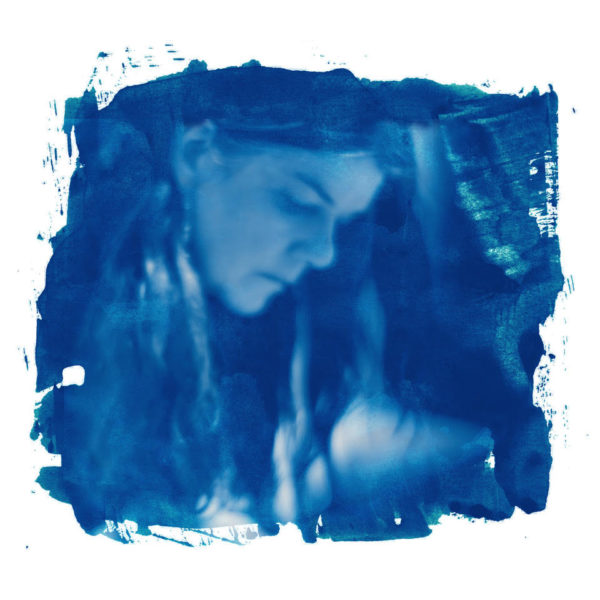
A new cyanotype self portrait Maura Allen created as part of a “HOMESCAPES” workshop with Santa Fe Workshop. The theme was finding beauty in the every day—at home.
Four years ago, mixed media artist Maura Allen moved from the bustling Colorado capital of Denver to the peaceful remote city of Prescott, Arizona. There in the wide, open spaces of this beautiful Southwestern city, Maura Allen has built for herself a new home, life, and studio. We at Gallery MAR wondered, how might this move impact Maura Allen’s work and process?
We caught up with the artist over Zoom to find out. We hope you’ll enjoy our conversation with such an insightful, thoughtful artist, covering a range of fascinating topics from the impact of her move to the Southwest to her new exploration of glass as media to her latest museum shows.

A landscape shot taken by the artist around her new home in Prescott, AZ, featuring a dazzling combination of pine trees and cacti, unique to the Southwest.
Gallery MAR: Recently, you moved from Denver, CO to the more remote city of Prescott, AZ. Do you feel that this move and the wide open spaces that accompany it have impacted your work and process?
Maura Allen: Definitely! There’s a different sensibility on texture, color, and openness. I’m not surrounded by the loud music of urban life. Out here, the music of life is more like quiet conversations. Plus, when I’m home, I’m home. I rarely leave.
Gallery MAR: What do you find most inspiring about your new home?
Maura Allen: The open space. The open space and the easy pace of life. My studio is now just 12 ft from the house.

Maura Allen documents quiet, beautiful moments in nature around her new home, inspiring a new palette.
Gallery MAR: How has the pandemic affected your work and life? I imagine you haven’t been able to travel and photograph your Western subjects as often. How have you been keeping that inspiration alive when you don’t have as great of access to that kind of iconography?
Maura Allen: As far as the rodeos, some rodeos have still gone on with social distancing, but some horse drives and ranch visits that I scheduled weren’t able to happen anymore. Instead, I’ve used this time to go back through my archive. I have a hundred thousand Western images, from over the last 20 years, so now I have a chance to look at them in new ways. I have new and different materials to use in an art piece.
Plus, since I am often on the road, the pandemic and being close to home has been a catalyst to explore what is right in front of me—in my new state of AZ and what’s right in front of me. While the southwest is certainly dominated by a warm glow, I’ve also started to explore the morning light, including cool tones and delicate shapes in the landscape. Also, the dreamy quality when night becomes day. All these moments influence my work in the studio—the colors I gravitate toward, the stories I want to tell.

Maura Allen looks through her archives, fondly recalling some Blue Sky Ranch cowgirl moments.
Gallery MAR: Many of your latest pieces are beautiful glass works. What inspired you to start working with glass?
Maura Allen: I’m always looking for new ways to push the boundary in art. I find the glass material interesting because it can be manipulated in so many different ways – it can be shiny or matte, it can be flat or shaped. I first explored clay as a possibility for new media, butt clay and painting didn’t quite mesh for me. Pottery can get very messy very quickly, whereas glass is a little cleaner. It’s similar to underwater photography. It’s a whole world that we don’t even think about that could be explored. It’s like a wild frontier or new terrain. It also informs the way I think about photography and painting. Using different mediums and pushing the boundaries of each allows me to see each one differently. I don’t think of siloed visual art, I think of how they swim together. I prefer to be creative and curious with each.
So I started exploring glass about three years ago. I gave myself a window to take almost my own version of a Masterclass, teaching myself the science and an understanding of the materials and taking advantage of the wealth of online learning available. What I wanted to do was to honor the material, honor the translucency of glass, the light transmits through it. I really wanted to understand the material and how to push the boundaries of the science of glass, not just take what I’d done on wood and steel.
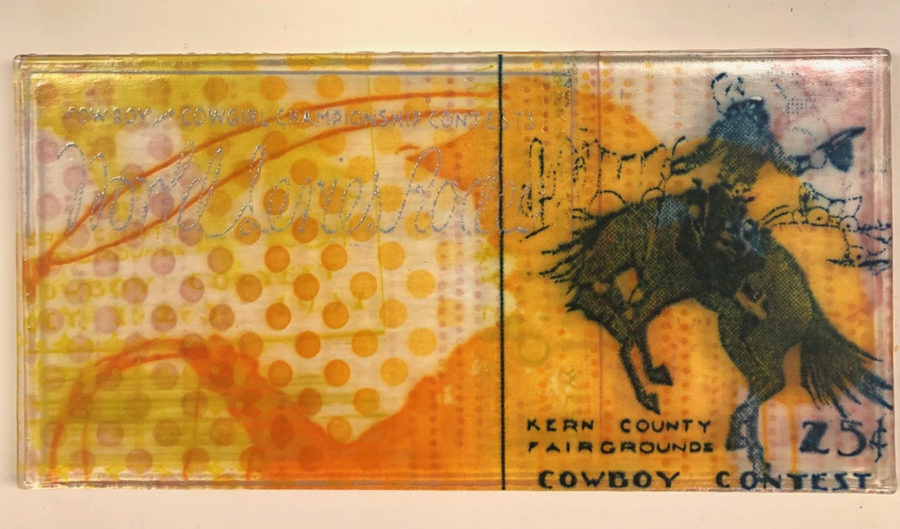
Maura Allen explores the science and art of glass.
Gallery MAR: Your recent glass works have this dream-like quality to them. The glass almost looks encaustic in the way that it slightly obscures its subjects, giving it a gorgeously nostalgic quality. How did you arrive at this aesthetic and what was your inspiration for this latest series?
Maura Allen: I like to say that, “some narrative of the past is always present through the West.” I’m interested in having that idea come through the glass medium. Glass can be similar to encaustic or wood work in the way that you work from the back forward. But with glass, you can work on both sides of the material. In that way, just 3 millimeters of glass creates a mile of distance in your mind. The way we see how our eye travels can now be explored in a different way through glass. (Interesting note: glass wants to be 6 mm, it wants to expand to be 6 mi, you have to hold it, damn it, keep it in) The way that I create the glass cubes, it creates almost this diorama. Through glass media, we become artist-scientists.
I’ve been exploring a more moody feeling lately. The idea that “the past is always present” can come through in the way an image is treated. For instance, we think of images as old if they’re in black and white. There are ways, as an artist, that I can tell a story using different printing processes: a different sensibility of color, treatment of image, elimination of certain things, etc.

A detailed shot of the texture and layers of Maura Allen’s latest glass work
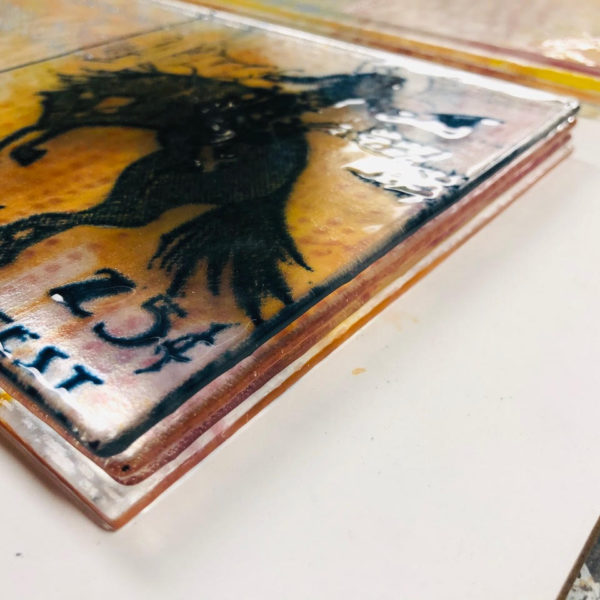
Maura Allen creates the illusion of depth with layers of glass, only 3 mi thick
Gallery MAR: What is it like working on such a smaller scale?
Maura Allen: Part of the science of glass and the reality of real estate is the size of the kiln. I just invested in a larger kiln for larger pieces (12” x 12″ or 14” x 14”). Small pieces still tell a big story though, whether on their own or through a combination of smaller pieces. I can combine a few small works to have imagery cross over different panels. Or the glass can have different depths like in my wooden Western quilts. That depth creates a feeling of movement back and forth.
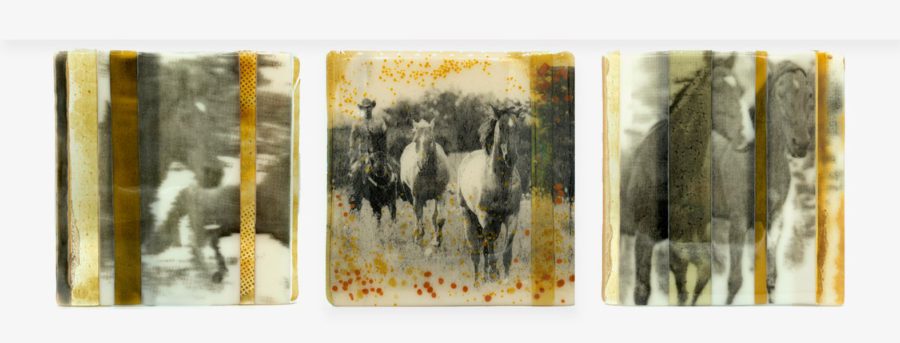
Maura Allen creates a narrative by combining smaller glass work as in her work at Gallery MAR, “Copper Longitude,” glass, 10″ x 32″
Gallery MAR: You have work in Desert Caballeros Western Museum in Wickenburg, Arizona for their “Cowgirl Up!” exhibition. I was able to take a virtual tour of the show. It’s an absolutely stunning collection. Could you talk a little about what it’s like having your work represented in museums?
Maura Allen: I’m proud to say this is my 9th year in “Cowgirl Up.” My first year in the show the overall collection of work was very traditional western. My work, which is contemporary and modern West, felt very different. However, over time, the show, just like the market, has moved towards a combination of traditional and modern. It’s interesting to see how these styles can mix together and inform each other. I’m grateful for the ways that the show has created a community of artists now connected to each other. As an artist, you’re often working by yourself, so having this community, whether in person or online has meant a lot in terms of inspiration, process sharing, ideas, support, etc. Having art in a museum show also builds a sense of credibility for both artists and collectors. It’s a juried show every year with 50+ women artists presenting the way that they see the West. This year, my work still has a contemporary Western feel but I do think I used a more traditional palette. Hanging in this year’s show is a 48”x 48” painting called Everybody’s Baby. It’s in a neutral palette and framed in a traditional way. But to the left, I have a modern day cowgirl with more vibrant colors like turquoise and red.
I often get asked, “Do you think that the Old West is a traditional thing of the past?” My thought is that there is an arch of time, and not this dichotomy of old vs new. It’s all part of a story. It’s how the artist chooses to share that story that makes it a part of their artistic expression. For instance, that’s part of what shaped the idea of my circular pieces. I lived in Rome for a while because I was a Latin major and circles are a part of the Renaissance iconography. It’s considered a very traditional format. Not every image is ideal for a circle and when I do paint something in a circle, I want to take advantage of that ancient porthole of a circle.
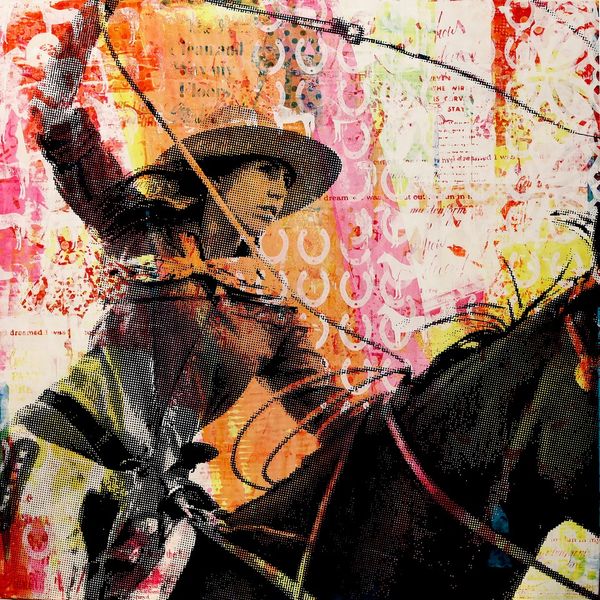
Maura Allen, “I Dream I Was,” mixed media, 30″ x 30″

Maura Allen, “That True West Fit,” acrylic, 30″ x 30″
Gallery MAR: What ideas, subjects, etc. are you currently excited about?
Maura Allen: Well, I’m still very excited about the West. Recently I sent two pieces to Gallery MAR that have this idea of how over time, outside culture and past culture and current day culture can collide in one piece. So I take advertising from the 50’s and focus on the way that they advertised to and portrayed women. I combine that with modern day cowgirl themes which embody the story of strength, boldness, and courage. It’s another way to emphasize how the past is always present in our culture. It’s this idea of how the past shapes ideas of ourselves today. One of the works uses material from an old Maidenform bra campaign called “I Dream I Was.” Its companion piece is how they advertise to men with bravado ads. I’m interested in how girls are raised differently than boys. In parts of western life, like on ranches, for instance, there’s actually greater equality between the way the boys and girls are raised. Young girls work side by side with their mother, father, uncle, doing the work. They’re out there feeding the horses regardless of gender. In that way, stewardship is equal opportunity work. Ranch work can be equal in that it’s a collective.
Written by Veronica Vale. We would like to extend a special thank you to Maura Allen for the delightful conversation. Check out the latest from the innovative artist here.
 Celebrate Sundance 2026 with Prints by Aaron Memmott
Celebrate Sundance 2026 with Prints by Aaron Memmott Fresh New Works from Bridgette Meinhold
Fresh New Works from Bridgette Meinhold Pantone's 2026 Color of the Year: Cloud Dancer
Pantone's 2026 Color of the Year: Cloud Dancer